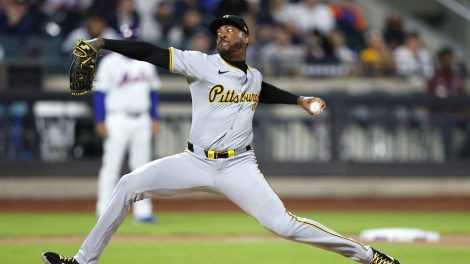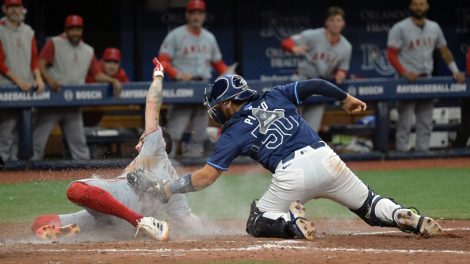DUNEDIN, Fla. – By the end of the 2017 season, Toronto Blue Jays president and CEO Mark Shapiro expects to have plans in place for both a new spring training facility and a Rogers Centre renovation that will run into the hundreds of millions of dollars.
The two projects remain in the planning stages, with a funding proposal for a revamped stadium and training site in Dunedin, Fla., currently under examination by officials at the Pinellas County level, and themes for what might be done at the dome emerging.
In that vein, the installation of natural grass at Rogers Centre remains a consideration although it may very well be an unlikely one with money instead being focused on a reworking of the seating bowl, expanded concourses and the creation of distinctive areas for different game-watching experiences.
“(Natural grass) is one of the decisions that has to be made in the context of the broader master plan that we’re still considering,” Shapiro says in an interview. “There is never a question of whether grass is preferred to artificial turf – grass is clearly preferred to artificial turf. It’s only going to be a question of what are going to be the one-time costs of retrofitting the entire stadium to do something it’s not equipped to do, which is irrigate, provide drainage, provide sunlight for times when the roof is not open to keep grass alive.
“Then there’s the annual commitment in costs that would create as well, and then weighing that versus how else you could spend that money on other things. By no means have we made that decision, but we’re going to look at that in the context of the other one-time decisions of renovation and on the annual basis of how else we can spend that money to help us win.”
[relatedlinks]
Already the Blue Jays are spending money on the Rogers Centre, with a new $1-million weight room installed over the winter and waterproofing work taking place on the concrete exterior. The retractable roof must also be replaced in the coming years, along with other less exciting upkeep tasks for a stadium that first opened in 1989, which is why Shapiro insists the entire project must be viewed holistically.
The Blue Jays have hired a design firm and at this point, “what we do have is themes that through focus groups and through research and through industry trends and analysis provided clear ideas of what we would be looking to achieve in a re-envisioning – and I call it a re-envisioning rather than a renovation – of the stadium.”
“No. 1,” Shapiro continued, “would be to turn the stadium into a ballpark. Very simply that would be a top priority for us, which means (providing) a modern ballpark experience for our fans. What I would hope is that by mid-summer we have those concepts fully flushed out, a potential set of loose designs, not plans but loose designs along with some costs so I can begin to have those conversations with ownership.”
While coming up with a vision for the dome and obtaining the funding are the primary challenges, a more complicated matter may be how to get the construction done without leaving the Blue Jays homeless.
“How do we play, understanding that we only have 20 weeks a year to do construction, or do we do some construction while we play?” says Shapiro. “I don’t have answers, those are the range of questions that have to be considered, because there’s no place else for us to play.”
The Dunedin project is further along, with concepts for a refurbishment for Florida Auto Exchange Stadium already drawn up although the new facility the Blue Jays want for the Bobby Mattick Training Center remains conceptual.
Architectural drawings won’t be drawn up until the funding is in place.
“We have what I’d call a program,” says Shapiro. “We have, room by room, what the square foot needs are. We haven’t yet laid that into a plan, although we have done a little bit of that and we’ve also thought about from a land-use perspective, this is where we might put a building, this is where we’d put 6½ fields, this is where we’d put a covered half-field, this is where the cages would go, that kind of thing.”
The Blue Jays gained Dunedin’s approval to seek funding for the $81-million project from the county back in September. Under the plan, Pinellas County would contribute about $46 million, the Blue Jays about $15.7 million, the state about $13.6 million and the city $5.6 million.
“The county has a process to walk through that both involves the (Tourist Development Council) and the country commission in determining if they’re going to agree to our funding proposal,” says Shapiro. “By the end of the season we’re going to have a plan in place. That plan might be we have to reconsider where we are from a spring training perspective. I hope not. You’ll seldom hear me say I’m optimistic, but I’m optimistic that’s not the case, I’m optimistic we’ll get something done here. But that’s not assured yet, that’s still very much something that’s being negotiated.”
A new spring facility has been one of Shapiro’s top priorities since taking over the job in November 2015. He had hoped to find a way to bring the Blue Jays’ spring stadium and training facilities together on a single site, but noted the team has “compromised already” by agreeing to an alternative plan in which all the training will be done at Bobby Mattick with the stadium used only for games.
The current separation “is a logistical challenge,” says Shapiro. “There’s not a time that I get in the car it doesn’t irk me a little bit that I’m driving 15 minutes to get to the other side. … It’s a challenge for us, not impossible, but a challenge for us until that happens. In my mind from the time I interviewed here, that is among the highest priorities.”









